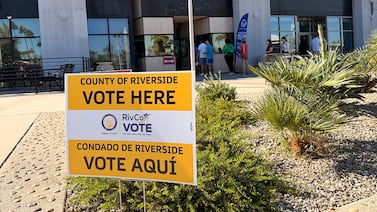Votebeat is a nonprofit news organization reporting on voting access and election administration across the U.S. Sign up for Votebeat’s free national newsletter here.
Just as he did during his first term in office, President Donald Trump is trying to reshape the census to serve his political goals.
This time, he’s calling for an extraordinary mid-decade population count that would be used for apportioning congressional seats, and that would explicitly exclude undocumented immigrants. He announced his intentions where many of his policy pronouncements start out, on social media.
It’s another effort by his administration to influence redistricting and congressional apportionment in ways that could benefit the GOP, though it’s not clear what the outcome of such a census would be. Democratic-leaning states like California, New York, New Jersey, and Illinois have large numbers of undocumented immigrants, but so do some Republican strongholds like Texas and Florida.
Trump’s previous attempt to change census procedures involved the scheduled 2020 census, and ran into a wall at the Supreme Court. This time, he’s trying to do it mid-decade, and for the purposes of apportionment, which would run into many more obstacles.
Here, we address some key questions about Trump’s proposal: the legality, the logistics, and the political strategy driving it.
Can a president order a mid-decade census?
Not unilaterally. The 1790 Census Act governs the census and gives authority over this process to the secretary of commerce and the Census Bureau. Certainly, the president has influence over this part of the executive branch. But Congress still controls the pursestrings and decisions over timing. A process like the one Trump is proposing must be authorized by law and funded through congressional appropriation, which Trump doesn’t control.
What does the constitution say about excluding undocumented residents?
There’s not a lot of ambiguity in the Constitution’s language about the census, or the way the Supreme Court has interpreted it: A census used to determine congressional seats needs to count everyone.
The 14th Amendment requires that the “whole number of persons” residing in the United States should be counted — it doesn’t mention immigration status, or any other condition. The phrase “whole number of persons” was written to replace the Three-Fifths Clause in Article 1 (which said enslaved persons were to be counted as three-fifths of a person for the purposes of apportionment), and was deliberately written to be inclusive, experts say.
Historical interpretations of this amendment reaffirm that. In 2016, Texas residents challenged the state’s use of total population, rather than just citizens, in deciding how to draw districts of roughly equal size, the process that follows the census and reapportionment of seats among states. The Supreme Court unanimously upheld a ruling that total population was the correct standard, based on the 14th Amendment, saying it “promotes equitable and effective representation.”
“What constitutional history and our prior decisions strongly suggest, settled practice confirms,” Justice Ruth Bader Ginsburg wrote for the court. Switching to apportionment based on eligible voters “would upset a well-functioning approach to districting that all 50 States and countless local jurisdictions have followed for decades, even centuries.”
How feasible would a new census be at this time?
It would be very expensive, if it could be done at all, and especially difficult to pull off on Trump’s timeline for influencing next year’s midterm elections. Election administrators, campaigns, and parties have already begun preparations for those elections based on figures from the previous census.
It’s difficult to pull off even when both parties want to do it.
In 1975, there was bipartisan interest in conducting a mid-decade census in order to provide better data for federal programs. Congress passed legislation authorizing a census for data collection only, not for congressional apportionment. But it didn’t get done. It proved too expensive, and the Census Bureau lacked the time and the infrastructure.
Getting Trump’s politically motivated proposal would have a tougher time just getting through Congress. And any attempt to politicize the census would be fraught. The data collected and compiled by the Census Bureau informs not just apportionment and redistricting, but many other public and private endeavors, from emergency planning and housing construction to wildlife conservation and school lunch programs. People and institutions that depend on census data want the most complete picture possible, not one clouded by political motives.
What legal obstacles does Trump face?
Beyond the statutory and constitutional limitations we’ve already talked about, the Census Act limits the White House’s ability to do what Trump is trying to do. And the president has no authority to compel states to draw new maps even if he’s successful at forcing a new census.
Along the way, judging by past disputes, we should expect a deluge of lawsuits that would diminish any chance of a census, reapportionment, and redistricting all getting done in time for next year’s midterms.
Is this related to the current redistricting effort in Texas?
Both reflect efforts by Trump to manipulate regularly scheduled democratic processes for partisan motives.
Redistricting after the census every 10 years has long been a politically driven process, where the party in charge at the state level typically tries to solidify — and perpetuate — its advantage. Texas Republicans did so in 2021, and as we’ve reported, Trump wants them to do it again this year, midway through the cycle, in an attempt to create five new Republican-leaning congressional districts. That way, Trump and his allies figure, Republicans would have a better chance of retaining their narrow majority in the U.S. House after the midterms, when the party in power typically loses seats.
Other states are threatening to do the same, to either help Republicans or try to thwart them.
A midcycle census would effectively broaden this battle for political power to all states. The carve-out for undocumented immigrants in population counts would shift political influence away from large Democratic strongholds, like California, New York, and Illinois, though it could also affect some GOP-dominated states that have large and growing populations of undocumented immigrants.
Hasn’t Trump tried something like this before?
During his first administration, Trump sought to influence the 2020 Census by calling for it to include a citizenship question. His explanation then was that the data was necessary to enforce the Voting Rights Act. But others saw it as a first step toward ultimately excluding noncitizens from the population counts used to apportion congressional seats and diminishing the power of states with large immigrant populations.
The Supreme Court ultimately blocked the administration’s effort, ruling that it lacked the authority to push through the change, and the 2020 census went out without the citizenship question. But immigrant rights groups complained that the publicity over that dispute may have compromised the data anyway. They raised concerns that noncitizens, whether they were in the country legally or not, would be afraid to respond to the census. The court battle also compressed the preparation time for the census, leaving less time for people to complete the surveys.
In July 2020, while the census was underway, the White House issued a presidential memorandum directing the Census Bureau to exclude noncitizens in the count it issues for apportionment, even though it had no citizenship question from which to sort out this number. Multiple Democratic-led states sued, arguing that the policy was unworkable and unconstitutional. The courts agreed, and blocked the plan from moving forward.
Jessica Huseman is Votebeat’s editorial director and is based in Dallas. Contact Jessica at jhuseman@votebeat.org.







